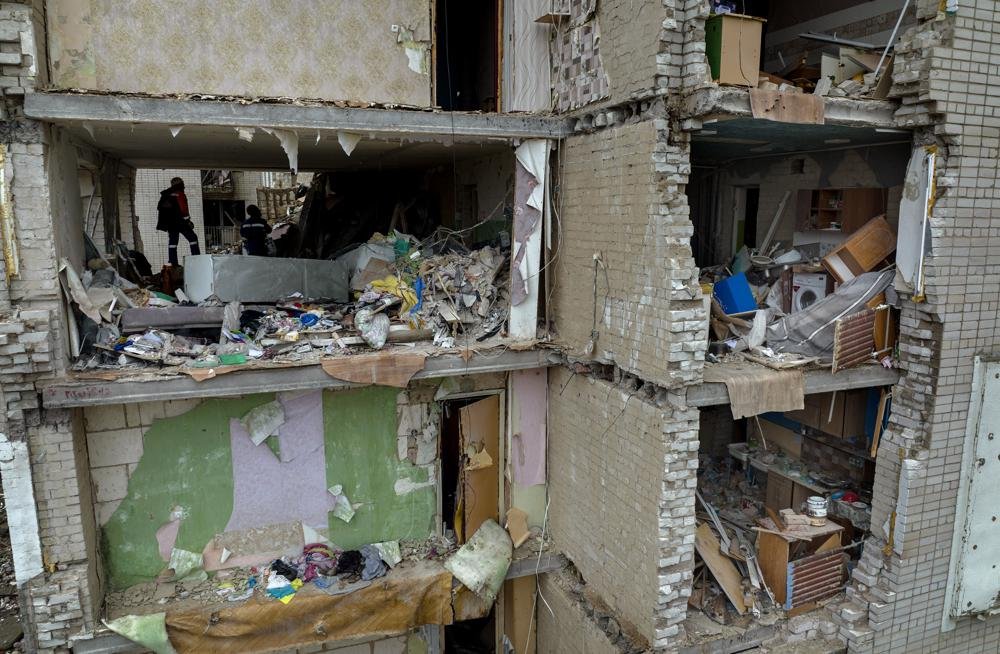ZAPORIZHZHIA, May 2 (AP): People fleeing besieged Mariupol described weeks of bombardments and deprivations as they arrived Monday in Ukrainian-held territory, where relief workers awaited the first group of civilians freed from a steel plant that is last redoubt of Ukrainian fighters in the devastated port city.
Video posted online Sunday by Ukrainian forces showed elderly women and mothers with small children climbing over a steep pile of rubble from the sprawling Azovstal steel plant and eventually boarding a bus.
More than 100 civilians from the plant were expected to arrive in Zaporizhzhia, about 140 miles (230 kilometers) northwest of Mariupol, on Monday, Ukrainian President Volodymyr Zelenskyy said.
The evacuation, if successful, would represent rare progress in easing the human cost of the almost 10-week war, which has caused particular suffering in Mariupol. Previous attempts to open safe corridors out of the city on the Sea of Azov and other places have broken down. People fleeing Russian-occupied areas in the past have said their vehicles were fired on, and Ukrainian officials have repeatedly accused Russian forces of shelling agreed-upon evacuation routes.
“Today, for the first time in all the days of the war, this vitally needed green corridor has started working,” Zelenskyy said Sunday in a pre-recorded address published on his Telegram messaging channel.
At least some of the people evacuated from the plant were apparently taken to a village controlled by Moscow-backed separatists, though Russian state media reported they would be allowed to continue on to Ukrainian-held territory if they wanted to. In the past, Ukrainian officials have accused Moscow’s troops of forcibly relocating civilians from areas they have captured to Russia; Moscow has said the people wanted to go to Russia.
While official evacuations have often faltered, many people have managed to flee Mariupol under their own steam in recent weeks. Others are unable to escape.
“People without cars cannot leave. They’re desperate,” said Olena Gibert, who was among those arriving an a U.N.-backed reception center in Zaporizhzhia in dusty and often damaged private cars. “You need to go get them. People have nothing. We had nothing.”
She said many people still in Mariupol wish to escape the Russian-controlled city but can’t say so openly amid the atmosphere of constant pro-Russian propaganda. A siege of the city since the early days of the war has trapped civilians in terrible conditions, with scarce access to food, water, medicine and electricity. They have suffered intense bombardment, including a Russian airstrike on a maternity hospital and the bombing of a theater.
Anastasiia Dembytska, who took advantage of the brief cease-fire around the evacuation of civilians from the steel plant to leave with her daughter, nephew and dog, told The Associated Press her family survived by cooking on a makeshift stove and drinking well water.
She said could see the steel plant from her window, when she dared to look out.
“We could see the rockets flying” and clouds of smoke over the plant, she said.
A defender of the plant said Russian forces resumed shelling the plant Sunday as soon as some civilians there were evacuated.
Denys Shlega, commander of the 12th Operational Brigade of Ukraine’s National Guard, said in a televised interview that several hundred civilians remain trapped alongside nearly 500 wounded soldiers and “numerous” dead bodies.
“Several dozen small children are still in the bunkers underneath the plant,” Shlega said. It was unclear whether there would be further evacuation attempts.
Before the weekend evacuation, about 1,000 civilians were also believed to be in the sprawling, Soviet-era steel plant, along with an estimated 2,000 Ukrainian fighters. As many as 100,000 people may still be in Mariupol overall.
The city, which had a pre-war population of more than 400,000, is a key Russian target because its capture would deprive Ukraine of a vital port, allow Moscow to establish a land corridor to the Crimean Peninsula, which it seized from Ukraine in 2014, and free up troops for fighting elsewhere in the Donbas, now Russia’s main focus.
A Ukrainian officer at the plant urged groups like the U.N. and the Red Cross to ensure the evacuation of wounded fighters, though he acknowledged that reaching some of the injured is difficult.
“There’s rubble. We have no special equipment. It’s hard for soldiers to pick up slabs weighing tons only with their arms,” Sviatoslav Palamar, deputy commander of the Azov Regiment, told the AP in an interview. “We hear voices of people who are still alive” inside shattered buildings.
The Azov Regiment originated as a far-right paramilitary unit and is now part of the Ukrainian military.







